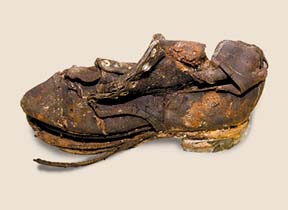
Friday, November 10, 2000


By Sgt. Shane Boucher, CILHI
Excavation site in Laos.
2. Recovery
Recovery teams venture from the top of Tibetan glaciers to deep underwater. Most of their work is done in dense jungles with highly acidic soil that eats away at artifacts. Shifting sand dunes change the topography of the land and render decades-old directions difficult to follow, and the occasional monsoon blows through, flooding the excavation area. At each site, anthropologists work systematically through an area, digging a series of trenches. Once bone, a tooth or artifacts are discovered, work shifts to shovels, trowels and whisk brooms. Sand and gravel are collected in buckets and sifted through filter screens. It took 90 days to excavate the 21-foot crater at the above site in Laos in January. The team found possible human remains and personal belongings.


WORLD WAR II: This shoe was among artifacts and human remains discovered at Makin Atoll. Nineteen soldiers and one islander were discovered in a mass grave for the Marines killed in the first U.S. amphibious strike on Aug. 17-18, 1942.

POST-WORLD WAR II: An administrative flight crashed in September 1945, in the mountains of Irian Jaya, Indonesia, killing five passengers and three crew members. In 1996 a recovery team found many personal belongings, such as the compass, razor and baseball mitt shown, but the owners of the items could not be determined. Excavation took place at an altitude of 13,000 feet, and fog prevented the team from descending the mountain at night. The team split into two parts and took turns working and sleeping on the cliff.

VIETNAM WAR: An early version Colt Armalite-15 rifle was found in the Quang Nam-Da Nang region in Vietnam, near the remains of U.S. servicemen.

KOREAN WAR: Found in October 1998, this M-3 submachine gun was discovered next to a farmer's house when a woman living there dug a pit to store her kim chee.
CILHI policy prevents photographs of remains from being published.
All bones and teeth photographed are replicas.
E-mail to City Desk
© 2000 Honolulu Star-Bulletin
https://archives.starbulletin.com






